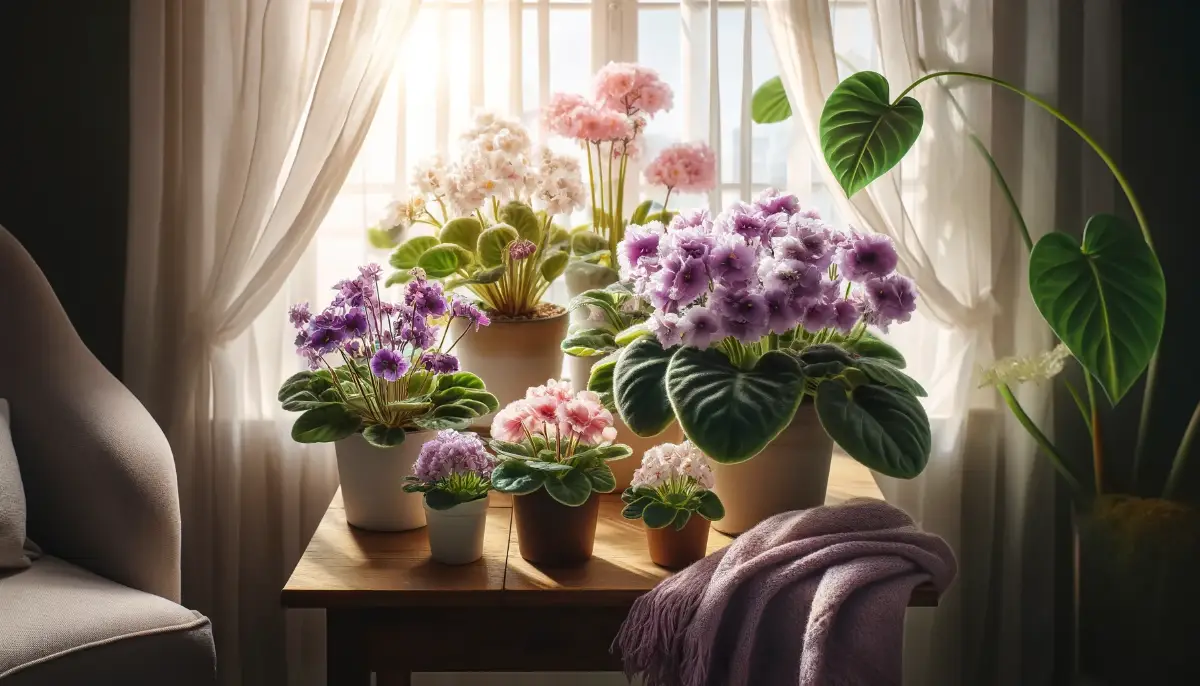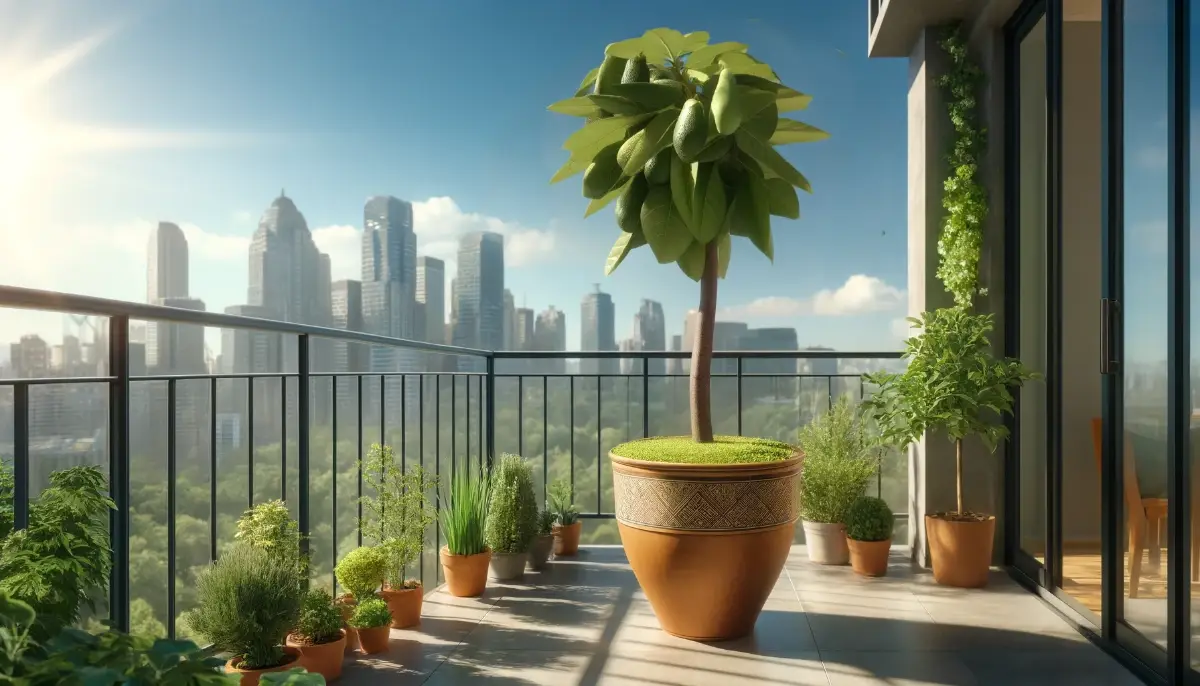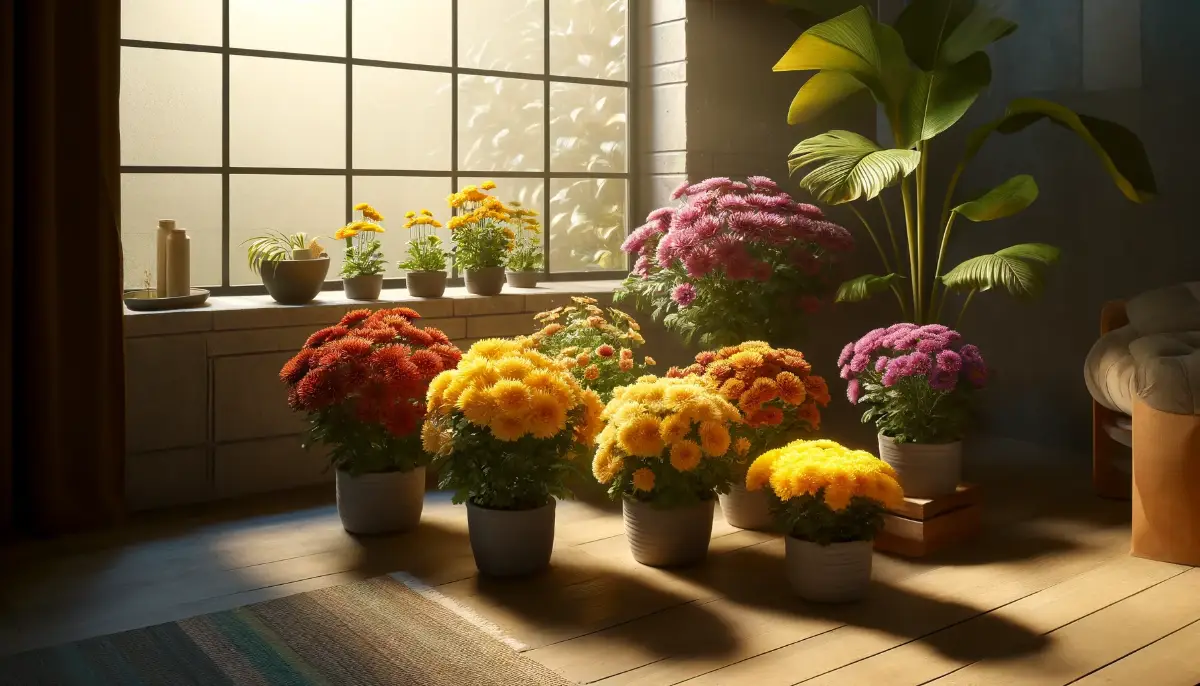African violets, scientifically known as Saintpaulia, have captivated indoor gardeners with their vibrant blooms and lush, velvety leaves, making them one of the most popular houseplants globally.
These small, charming plants offer a spectrum of colors, from deep violet to soft pink and pure white, adding a splash of color to any indoor setting.
Their compact size allows them to fit perfectly on window sills, shelves, or desks, where they bring a piece of nature’s beauty indoors.
Proper care is crucial for African violets to thrive. They demand specific conditions—like bright, indirect light, consistent moisture, and well-draining soil—to ensure they remain healthy and bloom prolifically.
Understanding the nuances of their care requirements can turn the daunting task of growing African violets into a rewarding gardening journey, filled with lush foliage and frequent flowering.
Basic Requirements for African Violets
- Optimal lighting conditions.
- Suitable soil composition.
- Correct watering techniques.
Choosing the Right Soil
Selecting the appropriate soil for African violets is pivotal to their health and blooming potential. These delicate plants require a specific type of soil composition that promotes good drainage while retaining adequate moisture. Here’s how to ensure your African violets have the best possible foundation:
Well-Draining Soil Mix
- African violets thrive in light, fluffy, and well-aerated soil to prevent waterlogging, which can lead to root rot. The ideal mix should include components like peat moss, perlite, and vermiculite in equal parts.
- You can either purchase a pre-mixed African violet potting mix from your local garden center or online, which is specifically designed to meet these criteria, or you can make your own by blending the recommended materials.
Improving Drainage
- If you opt to use a general potting mix, enhance its drainage by adding perlite. This amendment helps prevent compacting, ensuring the roots have enough air circulation.
- It’s crucial that the soil does not retain excess water. Check that the potting mix is loose and airy. Squeezing a handful should allow it to crumble easily, not clump together.
Read also: How to Use Normal Soil for Indoor Plants
Soil pH and Nutrients
- African violets prefer slightly acidic soil with a pH between 6.0 and 6.5. Testing your soil’s pH can help adjust it if necessary.
- While these plants require nutrient-rich soil, they are sensitive to over-fertilization. Look for soil mixes or fertilizers that are specifically labeled for African violets, as these will generally contain the correct nutrient balance for optimal growth.
By giving your African violets the right soil, you set them up for success, promoting healthy root systems and abundant blooms. Remember, while the initial setup requires some attention to detail, the payoff in lush foliage and vibrant flowers is well worth the effort.
Lighting Needs for African Violets
Proper lighting is essential for the health and flowering of African violets. Here are the best practices for lighting these delicate plants:
Type of Light
- African violets thrive under bright but indirect light. Direct sunlight can scorch their leaves, leading to damage and a poor appearance.
- They prefer light conditions that mimic the dappled sunlight of their native environment. This can be achieved by positioning them near a window that receives filtered light through sheer curtains or slightly shaded by other plants.
Window Placement
- The ideal window exposure for African violets is east- or west-facing. These orientations provide the gentle morning or late afternoon sun without the harsh midday rays that can burn the leaves.
- North-facing windows may also work if the light is not too dim; supplement with artificial light if needed.
Artificial Lighting
- If natural light is insufficient, especially in winter months, supplement with artificial lighting. Fluorescent or LED grow lights are excellent choices as they provide the necessary spectrum of light without excessive heat.
- Position the grow lights about 12 to 24 inches above the plants, ensuring the light covers all leaves evenly. Typically, African violets need about 10 to 14 hours of light per day to flourish and bloom properly.
Monitoring and Adjusting
- Observe the leaves for signs of insufficient light, such as elongated stems or smaller-than-usual leaves. Similarly, leaves that appear bleached or have dry, scorched spots might be receiving too much light.
- Adjust the placement of your African violets or the intensity of artificial lights based on these signs to find the perfect balance that encourages healthy growth and flowering.
By managing the lighting conditions carefully, you can ensure your African violets remain vibrant and healthy, producing stunning blooms that can brighten any indoor space.
Watering Properly for African Violets
Watering is one of the most crucial aspects of caring for African violets, and getting it right can make all the difference in the health and blooming of your plants. Here’s how to ensure your African violets are properly hydrated:
Use the Right Water
- Always use room-temperature water for your African violets. Cold water can shock the plants and cause leaf spots. If possible, use rainwater or distilled water to avoid the salts and chemicals found in tap water, which can accumulate in the soil and potentially harm the plants.
Watering Technique
- Water your African violets from the bottom to encourage the roots to grow downward and prevent water from touching the leaves, which can lead to spots or rot. Simply fill a tray with water and set the pot in the tray, allowing the soil to absorb moisture from the bottom up until the top of the soil feels moist.
- If you must water from the top, do so carefully to avoid getting water on the leaves. Use a watering can with a narrow spout to direct the water directly to the soil.
Frequency and Amount
- The frequency of watering will depend on factors such as humidity, light levels, and temperature. African violets prefer consistently moist soil but not soggy. Check the soil moisture by touching the top inch of the soil; if it feels dry, it’s time to water.
- Ensure that the pot has good drainage. After watering, allow excess water to drain out completely. Never let the plant sit in standing water as this can lead to root rot.
Humidity Needs
- African violets thrive in higher humidity environments. If your home is dry, particularly in winter months, use a humidity tray or a small room humidifier to maintain the ideal humidity level around your plants, which is about 40-60%.
More for How to Water Organic Indoor Plants
By mastering these watering techniques, you can keep your African violets healthy and blooming beautifully. Regularly monitoring your plants will help you adjust your watering practices to suit their needs and the specific conditions in your home.
Advanced Care for African Violets
- How to fertilize for best bloom.
- Repotting and propagation techniques.
- Recognizing and solving common problems.
Fertilizing Your African Violets Organically
To keep your African violets healthy and blooming, using organic fertilizers is a great way to provide them with necessary nutrients while adhering to natural gardening practices. Here’s how to organically fertilize African violets:
Choosing the Right Organic Fertilizer
- Opt for organic fertilizers that are high in phosphorus, which promotes blooming. Look for an N-P-K ratio where phosphorus (P) is higher, such as 1-3-1.
- Fish emulsion, seaweed extract, or worm castings are excellent organic options that provide a balanced range of nutrients while also being gentle enough for sensitive plants like African violets.
Application Frequency and Method
- During the growing season (spring and summer), fertilize every two weeks. In the dormant period (fall and winter), reduce the frequency to once a month as the plant’s growth slows down.
- Dilute the organic fertilizer to half the strength recommended on the package to avoid over-fertilizing, which can harm the plant. Over-fertilization can lead to salt build-up that may burn the roots and damage the plant.
Applying the Fertilizer
- Apply the diluted fertilizer solution directly to the soil, not the leaves. This method helps prevent leaf burn and ensures that the nutrients are absorbed where they are most needed – at the roots.
- Water your plant lightly before and after applying fertilizer to ensure even distribution of nutrients and to prevent root burn.
Monitoring Plant Health
- Observe your African violets after applying fertilizer for any signs of distress, such as wilting or discolored leaves, which might indicate over-fertilization or nutrient burn.
- Adjust the fertilization schedule based on the plant’s response. Healthy African violets will show vibrant foliage and steady bloom production.
Organic fertilization not only supports the robust growth of African violets but also contributes to a more sustainable and environmentally friendly gardening practice. By carefully selecting and applying organic fertilizers, you can enjoy lush, blooming African violets without the use of synthetic chemicals.
Repotting African Violets
Repotting is essential for keeping your African violets healthy as it refreshes the soil and provides room for root growth. Here’s how to repot these plants effectively:
When to Repot
- Repot African violets every 6 to 12 months or when they seem to outgrow their current pot, which is often indicated by roots peeking out of the pot’s drainage holes.
- The best time to repot is during their active growth period in spring or early summer.
Choosing the Right Pot
- Select a pot that is about one-third the diameter of the plant’s leaf span. African violets prefer snug pots, and being slightly root-bound can encourage more blooming.
- Ensure the new pot has adequate drainage holes to prevent waterlogging.
Repotting Process
- Gently remove the plant from its current pot, being careful not to damage the roots.
- Trim any dead or overly long roots to encourage new growth.
- Place fresh African violet potting mix in the new pot and position the plant so the crown (where the leaves meet the roots) is just above the soil surface.
- Water thoroughly after repotting, using room-temperature water, and keep the soil consistently moist as the plant adjusts to its new pot.
Propagation of African Violets
Propagation is a rewarding way to create new plants from your existing African violets. Leaf cuttings are the most common method:
Propagating by Leaf Cuttings
- Choose a healthy, mature leaf from the outer part of the plant. Snip the leaf at the stem, including a portion of the stem.
- Insert the stem end of the leaf into a mixture of moist vermiculite or a well-draining soil mix. You can also start the leaf in water until roots form, then transfer it to soil.
Caring for Cuttings
- Keep the soil or vermiculite consistently moist but not soggy.
- Place the cuttings in bright, indirect light. Roots typically begin to form in a few weeks, with new plantlets emerging from the base of the cut leaf.
Transplanting Plantlets
- Once the plantlets have developed several leaves of their own, gently separate them from the mother leaf and pot them individually in an African violet potting mix.
- Treat these young plants as mature African violets, with careful attention to their lighting and watering needs.
Both repotting and propagation are vital techniques to master for anyone looking to maintain or expand their collection of African violets. These steps ensure that your plants stay vibrant and continually blooming.
Common Issues and Solutions for African Violets
Caring for African violets can sometimes be challenging, with several common issues that might arise. Here’s how to identify and address some of the most frequent problems:
Leaf Spots and Rot
Problem: Water on the leaves can cause spots or rot, particularly if the water is cold or the room is low in humidity.
Solution: Always water from the bottom to avoid wetting the leaves. If you must water from the top, do so carefully and ensure the water doesn’t splash on the leaves. Increase room humidity to help prevent issues.
Leggy Growth or Pale Leaves
Problem: Leggy stems and pale leaves often indicate insufficient light. This can make the plant stretch towards the light source, weakening its overall structure.
Solution: Move your African violets closer to a light source but ensure it’s still indirect. Utilizing fluorescent or LED grow lights can also help provide consistent light levels.
Pests like Mealybugs and Mites
Problem: African violets can attract pests such as mealybugs and spider mites, which sap strength from the plants.
Solution: Use a cotton swab dipped in rubbing alcohol to gently remove pests. For severe infestations, consider organic insecticidal soaps or neem oil treatments. Regularly inspecting your plants can catch infestations early before they become severe.
Failure to Bloom
Problem: African violets may not bloom if they are not receiving enough light or nutrients.
Solution: Ensure your plant is getting 10-14 hours of bright, indirect light daily. If using artificial lights, adjust them to provide sufficient intensity. Fertilize regularly with a high-phosphorus, water-soluble fertilizer to encourage blooming.
Root Rot from Overwatering
Problem: Overwatering is a common issue that can lead to root rot, where the roots start decaying due to excessive moisture.
Solution: Ensure your potting mix is well-draining and your pots have good drainage holes. Water only when the top inch of soil feels dry to the touch, and always empty any water that collects in the saucer.
By addressing these common issues promptly and effectively, you can keep your African violets healthy and vibrant. Regular monitoring and adjustments to their care routine can prevent many problems before they start.
FAQs about African Violets
What is the best soil mix for African Violets?
African Violets thrive in light, fluffy, well-draining soil. A mix of peat moss, perlite, and vermiculite is ideal. You can also buy pre-mixed African Violet soil from garden centers.
How often should African Violets be watered?
Water when the top inch of the soil feels dry. Always use room-temperature water and consider watering from the bottom to avoid getting water on the leaves, which can cause spots.
Do African Violets need sunlight?
They require bright, indirect sunlight. Direct sunlight can scorch their leaves, so it’s best to place them near a window with filtered light or under fluorescent lights.
How do I get my African Violet to bloom?
Ensure sufficient indirect lighting, regular feeding with a high-phosphorus fertilizer during the growing season, and keep the soil consistently moist but not soggy.
Can I use tap water for my African Violets?
It’s best to use rainwater or distilled water as tap water may contain minerals and chemicals that can build up in the soil and harm the plant. If you must use tap water, let it sit out overnight to allow chlorine to dissipate.
Why are the leaves on my African Violet turning yellow?
Yellowing leaves can be caused by overwatering, poor drainage, or a nutrient deficiency. Check the watering schedule, ensure good drainage in the pot, and consider a balanced fertilizer.
How often should African Violets be repotted?
Generally, repotting every 6-12 months is a good practice to refresh the soil and provide room for growth. Always repot in spring or early summer during their active growth phase.
Can African Violets be grown from seeds?
While possible, African Violets are most commonly propagated from leaf cuttings as growing from seeds can be very challenging and time-consuming.
What is the best temperature for African Violets?
They prefer indoor temperatures between 65-75°F (18-24°C) during the day and slightly cooler at night. Avoid placing them in drafty areas or near heating and cooling vents.
How do I deal with pests on my African Violets?
Mealybugs and spider mites are common pests. Treat infestations with a cotton swab dipped in rubbing alcohol or use an organic insecticidal soap. Regularly inspect your plants to catch pests early.









